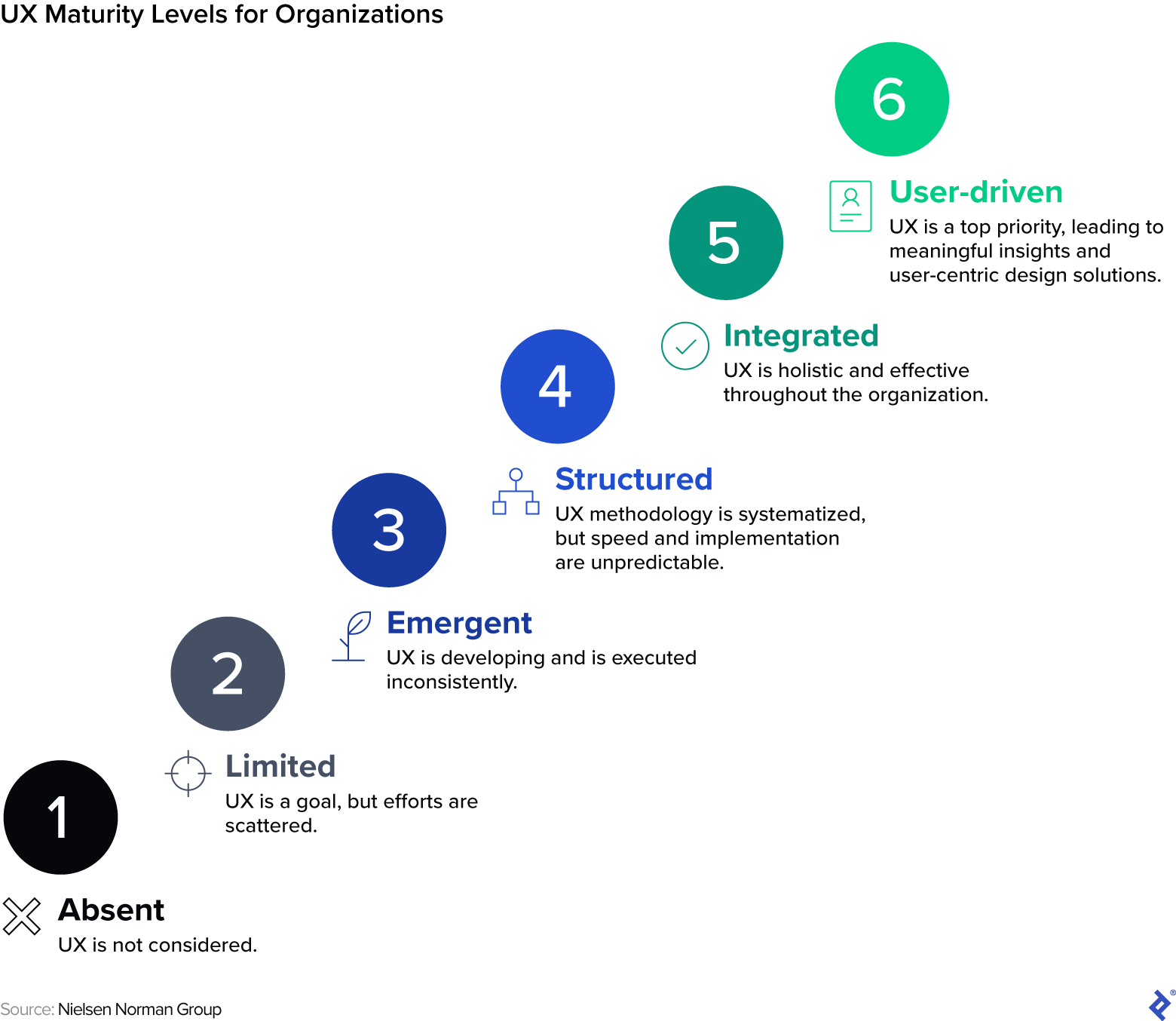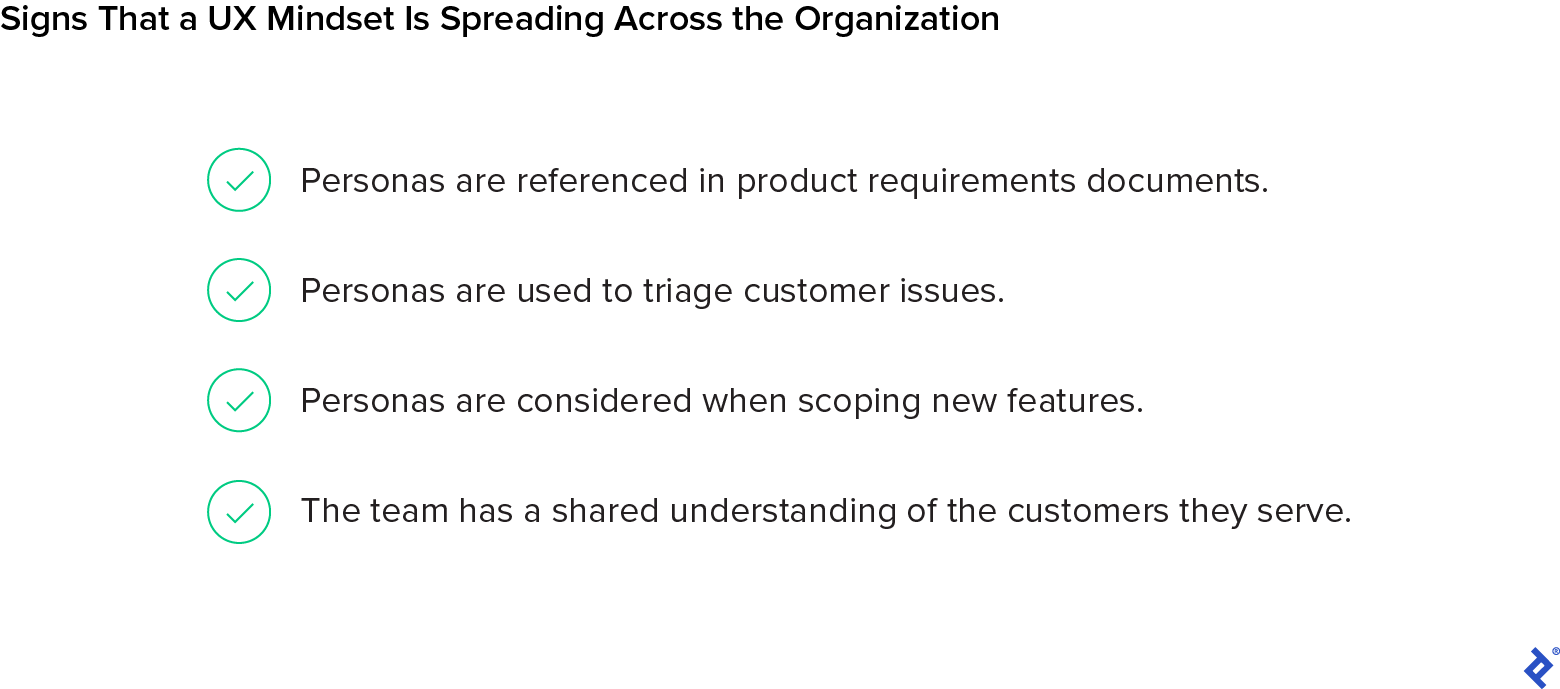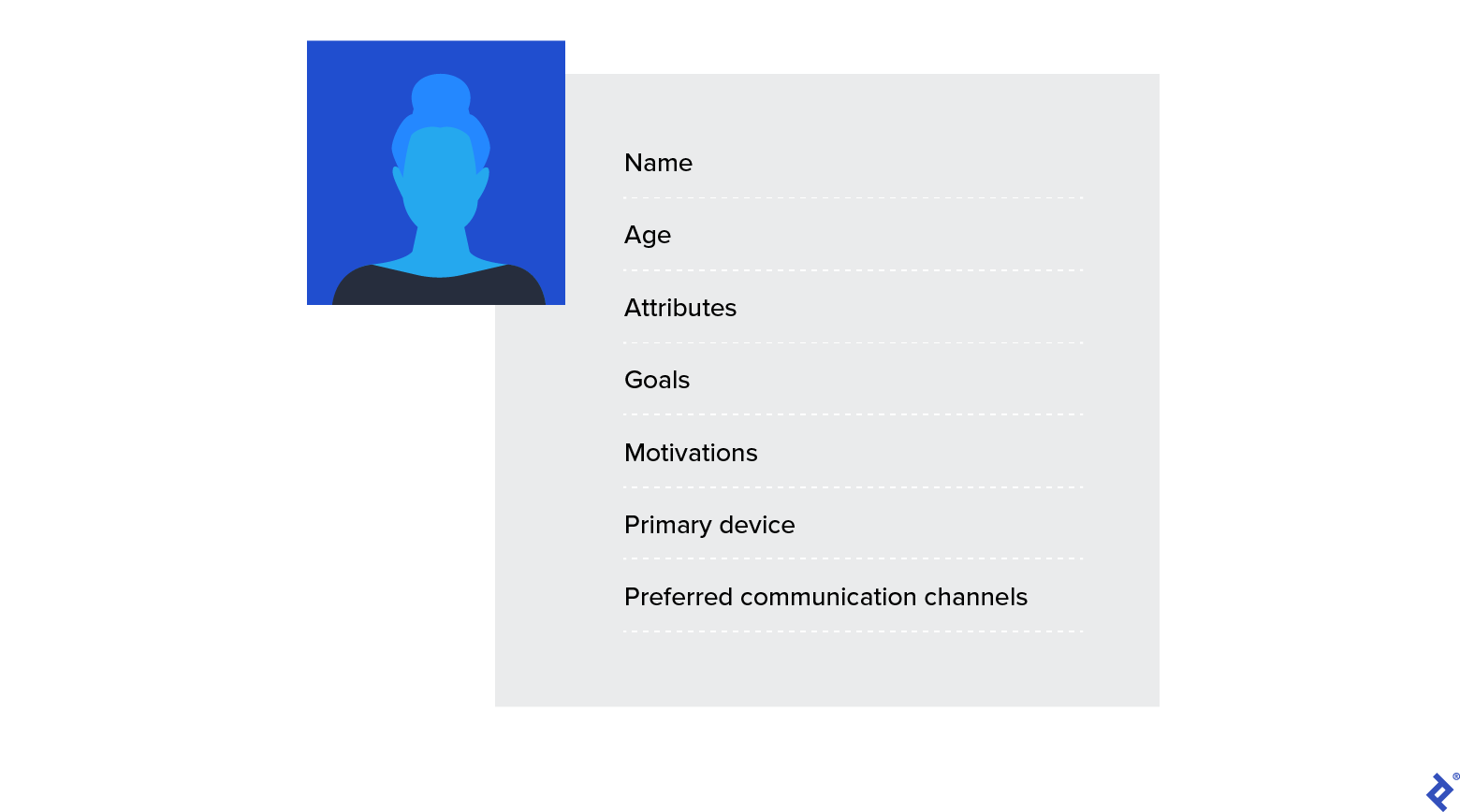Advance Your Organization’s UX Maturity With User Personas
User personas help companies increase UX maturity and establish more effective design practices—improvements that may grow revenue and create positive ripple effects across organizations.
User personas help companies increase UX maturity and establish more effective design practices—improvements that may grow revenue and create positive ripple effects across organizations.
Florence is a senior product designer with experience in building and scaling design systems, crafting design strategies, and developing user personas. She specializes in working with innovative startups, including Polywork, Carbon, Amplified Payments, and Shop-Ware. She is the Toptal Community Leader for Nigeria and a Toptal Design Mentor.
Expertise
Designers aren’t the only team members responsible for fostering an excellent user experience. Leadership, developers, product managers, marketers, and customer service representatives all impact a user’s interactions with a company’s products or services.
That’s where design maturity, or UX maturity, comes in. UX maturity is an organization’s ability to integrate design practices across teams, measure their efficacy ably and consistently, and support their connection to key user outcomes and business goals.
The McKinsey Design Index is a formula that measures how good design practices connect to business success. Over a five-year period, organizations that scored in the index’s top quartile achieved 32 percentage points higher revenue growth and 56 percentage points higher growth in shareholder returns than their industry peers. In short, UX maturity matters. Yet McKinsey also found that many business leaders treat design as an isolated function and have been slow to invest in its ability to transform their organizations.
One way to catch up is to develop user personas. I’ve worked with many clients over the years that were operating at lower UX maturity levels, and establishing user personas led to significant improvements that rippled across their organizations. Personas help companies better understand who their users are and what is going through their minds as they use an app or product. Personas also reveal how empathy makes product experiences more enjoyable and, ultimately, more profitable. Here’s how I’ve used personas at two companies to help advance UX design maturity.
Underscoring the Value of UX at a Digital Bank
When I joined a Nigerian-based digital bank as a UX designer, its services—which included bill pay, money transfers, loan applications, and online savings accounts—were only offered through an Android app, but an iOS version was in development. One of my first responsibilities was to conduct usability tests on a cross-platform feature that would allow customers in good financial standing, as measured by in-app spending, to obtain loans.
I met with the community manager, and we decided to recruit existing and prospective customers via a Google form distributed on Instagram, Twitter, and Facebook. More than 20 users responded to the solicitation. A key goal was to understand why, where, and how customers were using the app. To that end, we conducted user interviews to ask about personal spending habits (What do you spend money on? What strategies do you use to save money?) and preferred financial tools and services (How do you spend money? Where do you save money?).
Answers began to reveal a Linnaean pattern, falling into clusters of similar traits that could be grouped together. This is typical when you conduct a test with at least seven users. These clustered traits, along with competitive market research, begin to form the basis for personas.
Visualized on cards or digital mock-ups, personas typically include a human likeness, a user’s age and attributes, what they are trying to achieve, and their motivations for doing so. Another important aspect of persona development—in the digital bank’s case, probably the most important—is pinpointing a user’s preferred devices and communication channels.
The user interviews we conducted led to an important discovery: Android and iOS users fell into two distinct camps. Android phones, typically cheaper than iPhones, were often people’s “second phones.” They were used less frequently and for quick, one-off tasks. Android app users primarily wanted the ability to quickly take out low-interest loans. iOS users, on the other hand, were willing to spend more time on the app and use it to add money to their savings accounts.
This was a crucial insight for the development team. To drive home the point, I created cardstock images of the distinct personas and displayed them in conference rooms and other shared spaces. This helped build social awareness of the core users we were designing for, so employees across the organization could visualize them as people with names and faces.
One of the best ways to measure the UX maturity of an organization is via the Nielsen Norman Group’s six stages of design maturity: absent, limited, emergent, structured, integrated, and user-driven. (Other measurement models include The New Design Frontier and The Six Levels of Design Maturity.)
Most companies I’ve worked with tend to fall in the “absent” or “limited” categories, leaving ample room for improvement. While the banking client had been operating at the “absent” stage of UX maturity in the past, the user personas exercise helped leaders acknowledge the value of UX activities to business goals—a critical step in progressing to a higher level of design maturity.

Proceeding from one stage of design maturity to the next doesn’t happen overnight. If a company is at the lowest stage—“absent”—the designer’s first responsibility is to be an advocate: hosting meetings and lunch-and-learn sessions to educate employees about UX, demonstrating its value to customers and the organization, and explaining processes such as user interviews, surveys, card sorting exercises, and A/B tests.
Without building UX awareness within an organization, it’s nearly impossible to progress beyond the “limited” stage, where UX activities are sporadic and constrained to siloed teams. But when combined with a UX budget, designated UX roles, and a product roadmap, the introduction of user personas can illustrate the business value of design to key stakeholders.
Establishing Customer-centric Workflows at a Software Company
When I began working as a senior product designer at a high-growth SaaS company in the auto repair industry, the San Francisco-based firm performed at the “emergent” stage of UX maturity. While we worked on user personas in person at the digital bank, we worked remotely to develop personas at the auto repair company.
The first step was to recruit shop managers and technicians for user interviews. In an effort led by the product manager and a lead designer, more than 20 video call interviews were recorded to gather qualitative feedback about the product. Research has shown that five user interviews will uncover about 80% of usability issues, but in this case, we also wanted to review the raw audio data to extract common goals, barriers, and motivations that would form the basis for personas. Dropbox’s co-editing tool, Paper, allowed us to convert the audio files into a readable format we could comb through to identify key insights.
Using the online whiteboarding tool FigJam, we hosted a virtual ideation workshop to synthesize these findings into more fully developed persona cards and maps. The design and product teams, along with key members of all departments, could view the boards in real time and add sticky notes and comments to help refine ideas. Even the company’s founder and CEO attended the workshop and shared her expertise.
Meet Liam and Mary, Two of Our Fictitious Customers
After research and ideation, we were ready to develop the user personas. On the customer side, we created a persona modeled on car owners’ experiences using the company’s software to view auto repair estimates, chat with service retailers, and approve repair jobs and costs.
On the auto shop side, we developed five distinct archetypes: the front desk operator, the service writer, the owner, the manager, and the mechanic/technician. Each of these personas appeared on the FigJam board with their own name, responsibilities, motivations, needs, and attitudes.
Liam, for example, is a fictitious mechanic who inspects cars, predicts outcomes, estimates costs, and repairs vehicles. We inferred he often has greasy hands. Why does that matter? Because the interface should limit the number of times he needs to touch or swipe a screen. Quick buttons and voice commands can help improve his experience.
Mary, the front desk operator, has different needs. Her chief responsibility is to schedule repair appointments, ideally as quickly as she can. She needs a fast-loading user flow that is digestible at a glance and operates intuitively without hiccups.

These personas have been particularly useful to the company’s product and engineering teams, whose heightened understanding of users’ needs is evident in their workflows. Product requirements documents consistently refer to specific personas. Customer issues tracked in Jira are grouped and triaged by personas. The needs and motivations of users are top of mind as product managers scope new features and pages, and engineers code them into shippable updates.
Personas also save time. New employees no longer have to read a lengthy text file to get up to speed on the customers they’re serving—the personas serve as a quick reference. Online lunch-and-learns introducing the personas to employees across the organization have helped illuminate their importance to the product development process.
The Nielsen Norman Group notes that “emergent” organizations are still in the process of proving UX’s value, and to progress from this stage, organizations should establish a culture that prioritizes UX at all levels. Persona development represents a bold step in this direction. Inviting product, development, and marketing teams into the process of asset creation has arguably elevated the auto repair company to the “structured” UX maturity stage, where the organization appreciates UX’s value and executes user research throughout the product life cycle.
Laying the Groundwork to Advance to Higher Stages
User personas introduced leaders to the value of UX at the digital bank where UX maturity had been “absent”—a first step toward developing better design practices. And at the “emergent”-level auto repair software company, personas made procedures across a range of teams more user-centric.
Wherever an organization sits in terms UX maturity, personas can support its business goals. Advancing through the stages takes time, and while designers can’t make UX maturity happen in a vacuum, they can leverage user personas to spread a UX mindset and help businesses continuously improve.

How do you know when you’ve arrived at a new stage? Listen to how your colleagues talk about UX. What vocabulary are they using to describe users and their needs? Do people operate with a common understanding of what design means? Is UX work the responsibility of a single discipline or part of a shared, iterative process?
Ultimately, progressing to higher stages of maturity requires designers to become champions for the work they do. You’ll know you’re moving in the right direction when colleagues outside the design team begin to come to you with questions—when your product manager approaches you, as mine did, and says: “We’re thinking about rolling out a new feature, but we want to do some user research first.” Translation: Can you help?
Gladly.
Understanding the basics
What is UX design maturity?
UX design maturity assesses how well an organization integrates design practices across different teams. Companies that demonstrate a high level of UX maturity consistently measure design efficacy and connect design practices to user needs and business goals.
Why is UX maturity important?
UX maturity is important because it measures traits that can have a positive impact on business results. For example, in a study, companies that demonstrated good design practices experienced higher revenue growth than industry counterparts.
What does UX maturity look like?
Nielsen Norman Group’s UX maturity model defines six stages: absent, limited, emergent, structured, integrated, and user-driven. Shopify and Airbnb are examples of companies that have reached a high level of design maturity: They research and leverage user personas to tailor messaging and offerings to different customer groups.
Guimaraes, Portugal
Member since January 22, 2020
About the author
Florence is a senior product designer with experience in building and scaling design systems, crafting design strategies, and developing user personas. She specializes in working with innovative startups, including Polywork, Carbon, Amplified Payments, and Shop-Ware. She is the Toptal Community Leader for Nigeria and a Toptal Design Mentor.



